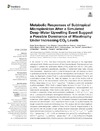Identificador persistente para citar o vincular este elemento:
https://accedacris.ulpgc.es/jspui/handle/10553/72325
| Título: | Metabolic Responses of Subtropical Microplankton After a Simulated Deep-Water Upwelling Event Suggest a Possible Dominance of Mixotrophy Under Increasing CO2 Levels | Autores/as: | Tames Espinosa, Maria Teresa Martínez Sánchez, Ico Romero Kutzner, Vanesa Coca Saenz De Albéniz, Josep Algueró-Muñiz, María Horn, Henriette G. Ludwig, Andrea Taucher, Jan Bach, Lennart Riebesell, Ulf Packard, Theodore Train Gómez Cabrera, María Milagrosa |
Clasificación UNESCO: | 251001 Oceanografía biológica | Palabras clave: | Ocean acidification Mesocosms Nutrient fertilization Subtropical North-Atlantic Potential respiration, et al. |
Fecha de publicación: | 2020 | Publicación seriada: | Frontiers in Marine Science | Resumen: | In the autumn of 2014, nine large mesocosms were deployed in the oligotrophic subtropical North-Atlantic coastal waters off Gran Canaria (Spain). Their deployment was designed to address the acidification effects of CO2 levels from 400 to 1,400 μatm, on a plankton community experiencing upwelling of nutrient-rich deep water. Among other parameters, chlorophyll a (chl-a), potential respiration (Φ), and biomass in terms of particulate protein (B) were measured in the microplankton community (0.7–50.0 μm) during an oligotrophic phase (Phase I), a phytoplankton-bloom phase (Phase II), and a post-bloom phase (Phase III). Here, we explore the use of the Φ/chl-a ratio in monitoring shifts in the microplankton community composition and its metabolism. Φ/chl-a values below 2.5 μL O2 h−1 (μg chl-a)−1 indicated a community dominated by photoautotrophs. When Φ/chl-a ranged higher, between 2.5 and 7.0 μL O2 h−1 (μg chl-a)−1, it indicated a mixed community of phytoplankton, microzooplankton and heterotrophic prokaryotes. When Φ/chl-a rose above 7.0 μL O2 h−1 (μg chl-a)−1, it indicated a community where microzooplankton proliferated (>10.0 μL O2 h−1 (μg chl-a)−1), because heterotrophic dinoflagellates bloomed. The first derivative of B, as a function of time (dB/dt), indicates the rate of protein build-up when positive and the rate of protein loss, when negative. It revealed that the maximum increase in particulate protein (biomass) occurred between 1 and 2 days before the chl-a peak. A day after this peak, the trough revealed the maximum net biomass loss. This analysis did not detect significant changes in particulate protein, neither in Phase I nor in Phase III. Integral analysis of Φ, chl-a and B, over the duration of each phase, for each mesocosm, reflected a positive relationship between Φ and pCO2 during Phase II [α = 230·10−5 μL O2 h−1 L−1 (μatm CO2)−1 (phase-day)−1, R2 = 0.30] and between chl-a and pCO2 during Phase III [α = 100·10−5 μg chl-a L−1 (μ atmCO2)−1 (phase-day)−1, R2 = 0.84]. At the end of Phase II, a harmful algal species (HAS), Vicicitus globosus, bloomed in the high pCO2 mesocosms. In these mesocosms, microzooplankton did not proliferate, and chl-a retention time in the water column increased. In these V. globosus-disrupted communities, the Φ/chl-a ratio [4.1 ± 1.5 μL O2 h−1 (μg chl-a)−1] was more similar to the Φ/chl-a ratio in a mixed plankton community than to a photoautotroph-dominated one. | URI: | https://accedacris.ulpgc.es/handle/10553/72325 | ISSN: | 2296-7745 | DOI: | 10.3389/fmars.2020.00307 | Fuente: | Frontiers in marine science [ISSN 2296-7745], Mayo (2020) |
| Colección: | Artículos |
Citas de WEB OF SCIENCETM
Citations
2
actualizado el 08-jun-2025
Visitas
164
actualizado el 01-feb-2025
Descargas
121
actualizado el 01-feb-2025
Google ScholarTM
Verifica
Altmetric
Comparte
Exporta metadatos
Los elementos en ULPGC accedaCRIS están protegidos por derechos de autor con todos los derechos reservados, a menos que se indique lo contrario.
